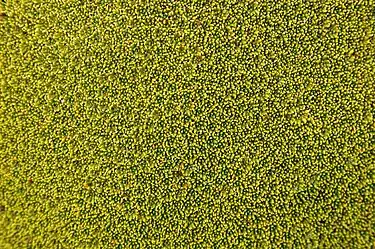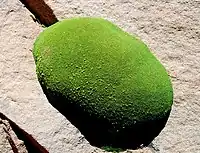Yareta
Yareta or llareta (Azorella compacta, known historically as Azorella yareta, from yarita in the Quechua language) is a flowering plant in the family Apiaceae native to South America. It grows in the Puna grasslands of the Andes in Peru, Bolivia, northern Chile, and western Argentina at altitudes between 3,200 and 5,250 metres (10,500 and 17,220 ft).[1][2]

| Yareta | |
|---|---|
.jpg.webp) | |
| in Lauca National Park, Chile | |
| Scientific classification | |
| Kingdom: | Plantae |
| Clade: | Tracheophytes |
| Clade: | Angiosperms |
| Clade: | Eudicots |
| Clade: | Asterids |
| Order: | Apiales |
| Family: | Apiaceae |
| Genus: | Azorella |
| Species: | A. compacta |
| Binomial name | |
| Azorella compacta | |
Description
Yareta is an evergreen perennial with pink or lavender flowers. The self-fertile flowers are hermaphroditic and are pollinated by insects.
The plant prefers sandy, well-drained soils. It can grow in nutritionally poor soils that are acidic, neutral, or basic (alkaline) at altitudes of up to 5,200 metres (17,100 ft).[2] Yareta is well-adapted to high insolation rates typical of the Andes highlands and cannot grow in shade. The plant's leaves grow into an extremely compact, dense mat that reduces heat and water loss.[3] This mat grows near the ground where air temperature is one or two degrees Celsius higher than the mean air temperature. This temperature difference is a result of the longwave radiation re-radiated by the soil surface, which is usually dark gray to black in the Puna.[3]
Yareta is estimated to grow approximately 1.5 centimetres (0.59 in) per year.[2] Many yaretas are estimated to be over 3,000 years old.[4] Its very slow growth makes the traditional practice of harvesting it for fuel highly unsustainable.[5]
Gallery
 Plant in crevice in Eduardo Avaroa Andean Fauna National Reserve, Potosí, Bolivia
Plant in crevice in Eduardo Avaroa Andean Fauna National Reserve, Potosí, Bolivia.jpg.webp) Close-up showing seeds
Close-up showing seeds_en_la_Isla_H%252C_Ushuaia%252C_Argentina.JPG.webp) Texture of surface
Texture of surface Flowers
Flowers
References
- "Image of Azorella compacta". chileflora. Retrieved 28 October 2015.
- Kleier, Catherine; Rundel, Philip W. (August 2004). "Microsite requirements, population structure and growth of the cushion plant Azorella compacta in the tropical Chilean Andes". Austral Ecology. 29 (4): 461–470. doi:10.1111/j.1442-9993.2004.01386.x.
- Wickens, G. E. (April 1995). "Llareta (Azorella Compacta, Umbelliferae): A review". Economic Botany. 49 (2): 207–212. doi:10.1007/BF02862926. ISSN 0013-0001.
- Stenger, Richard (2019-11-28). "The oldest living things on Earth". CNN Travel. Retrieved 2020-01-09.
- "See the world's oldest organisms".
External links
| Wikimedia Commons has media related to Azorella compacta. |